Rome: Total War Exclusive Hands-On
We had the chance to get exclusive hands-on time with Rome: Total War's single-player campaign, and it's everything we expected.
As the developers at Creative Assembly like to say, Rome: Total War wasn't built in a day. Indeed, when tasked with making the third game in the acclaimed Total War series, the developers studied the feedback from Shogun: Total War and Medieval: Total War and came away with detailed notes on how to improve the series. And while the most stunning and obvious new feature of Rome is the 3D graphics engine that can render thousands of warriors on the screen at once, there are pages upon pages of other improvements and enhancements in the game. We recently had a chance to get the first hands-on look at the game's single-player campaign anywhere.
One of the goals for Rome: Total War was to make the game playable without having to read the manual, and Creative Assembly has done this by integrating advisers into every aspect of the game. In the top left corner of the screen is a portrait of an adviser who, during the tutorial prologue, walks you through the game. During a regular campaign, you can click on an adviser for advice. So if you wonder which building to construct next in a city, for example, the adviser will suggest one and give you a reason for it. In addition to the advisers, Creative Assembly has also streamlined the previously complex gameplay to make it more accessible. Now, there's always some fear that when a designer "streamlines" a game for accessibility it means that it's being "dumbed down." However, from what we've seen and played of Rome: Total War, there's just as much strategic depth as there was in Medieval: Total War, only this time it's better presented.
Creative Assembly has done an excellent job so far of listening to feedback and addressing problems in the series. In Shogun: Total War, fans felt that the pace and flow of the game was hampered by the way events were presented in a separate, virtual throne room, so those aspects of the gameplay were integrated directly into the campaign map of Medieval: Total War. Meanwhile, one of the criticisms of Medieval: Total War was that the campaign map could become horribly cluttered with armies, assassins, princesses, emissaries, bishops, cardinals, and all the other unit types in the game. So for Rome: Total War, Creative Assembly has streamlined the campaign map by trimming down the unit types and getting rid of some of the secondary ones, like princesses. However, that doesn't mean that you can't marry off daughters of your house to cement alliances with other houses and generals in Rome: Total War. That aspect of the game has been integrated in the family tree and diplomacy screens, so you won't have to send your women on an around-the-Mediterranean chase for a husband.
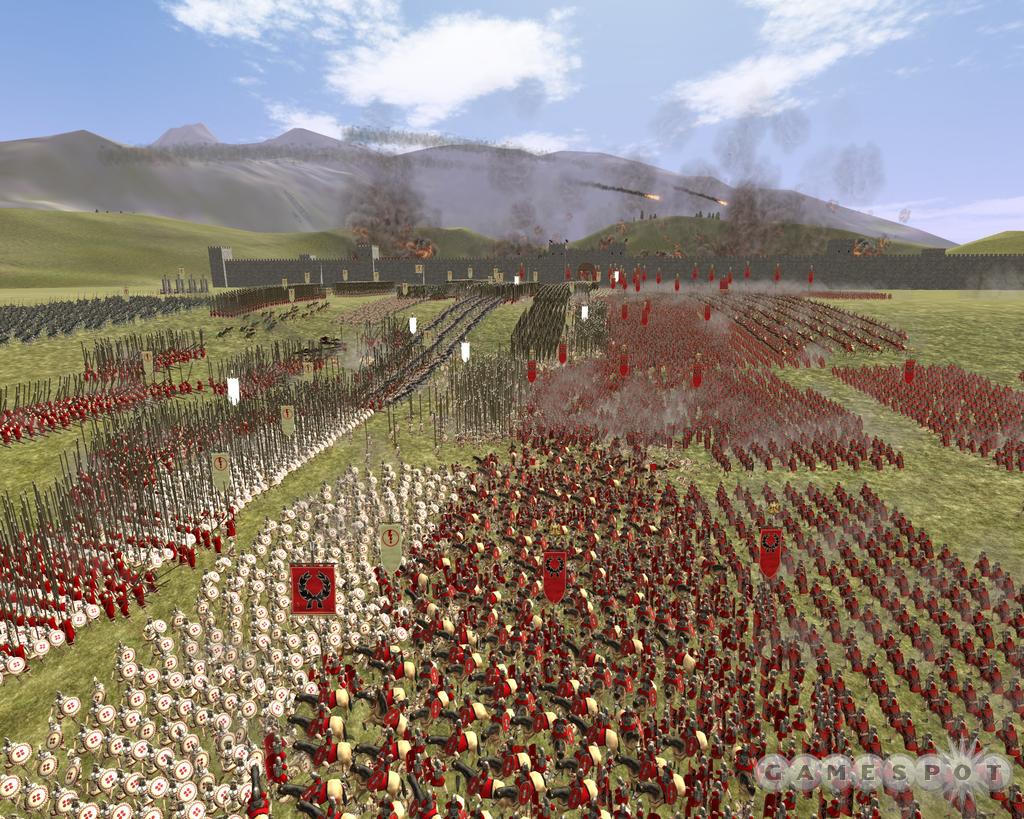
Another cool feature of Rome: Total War is that when you begin a game, you can select two different difficulty levels: one for the campaign map and the other for battles. This means that if you're the Total War fan who likes to mainly play the turn-based campaign game, you can ramp campaign difficulty to high and the battle difficulty to low, so that if you feel like playing an occasional battle it'll be easy. (You can also have the computer automatically generate battle results, so you can skip battles altogether.) And if you're the Total War fan who likes battles over the campaign, you can simplify the turn-based campaign so that you won't have to spend as much time thinking about strategy and you can focus more on the battles.
After you've selected which faction you wish to play, you'll be dropped into the beautiful new 3D campaign map, which presents the Mediterranean world in all its ancient glory. The world is no longer broken into provinces and territories, but instead it's presented as an organic whole. What that means is that when you move armies around, they no longer "jump" from province to province; instead, armies "occupy" the ground that they stand upon, and when they move they'll actually traverse across the map. For instance, if you plant an army in a mountain pass, it'll serve as a blocking force, and any army trying to pass through will have to assault the defenders. This increases the depth of the campaign game, as you can now station armies in strategic junctions or station them on defendable ground. So an army atop a mountain range that's attacked from an army located in a valley below will have the defensive advantage of the high ground, and that will be reflected on the battlefield as well.
Romans-Paper-Scissors
Your job during the campaign game is to grow the power and influence of your family's territory. Each of the three major Roman families has an area of influence, mainly indicated by cities that are under their control. Cities in Rome: Total War are important because they not only generate revenue in the form of taxes, but they are also the only place where you can recruit new units. You can also build up cities, improving their defenses and their wealth and size by constructing new buildings, such as temples that increase your influence. If you don't feel like micromanaging so many details, you can also assign a governor to a city and give him a goal of growing the city's fiscal power or focusing on military structures, and he'll go ahead and do it. And you can also change the tax rate for a city, though higher taxes will reduce the city's productivity and population growth, and it can foment a revolt if you're not careful.
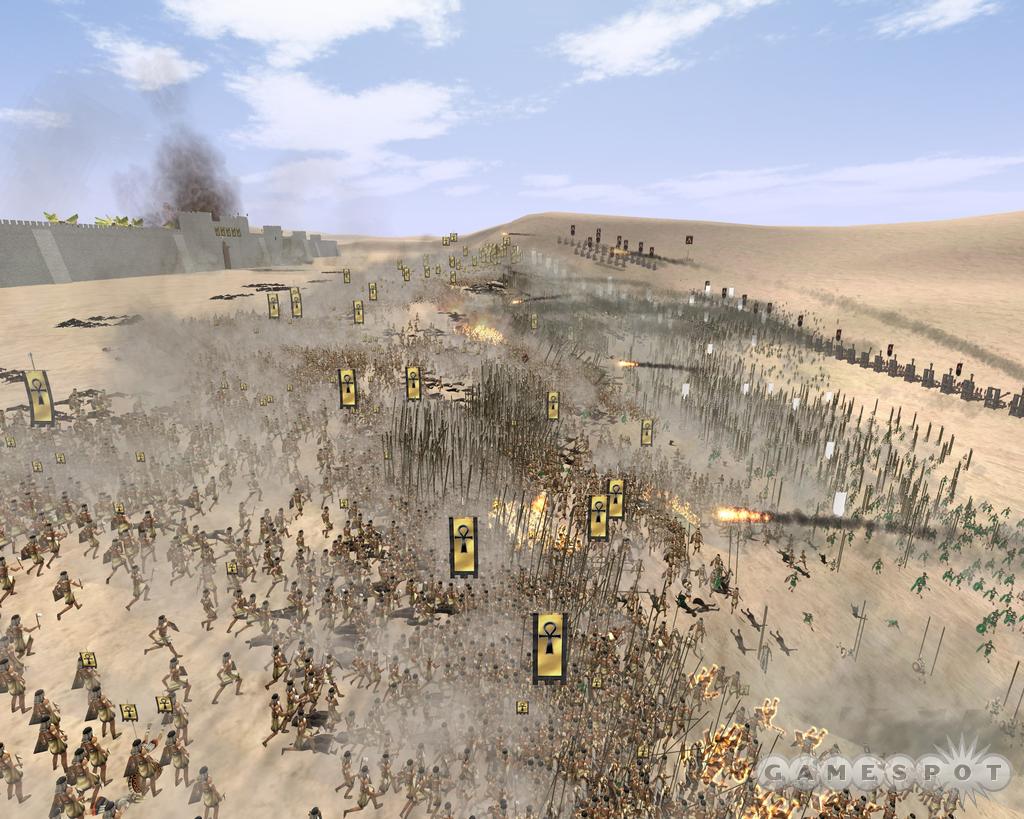
During the early part of the main Imperial campaign, your family only begins with a handful of cities, and you'll be dependent upon receiving missions from the senate to improve your prestige. For example, the senate may wish to test you by ordering you to capture Carthage within 10 turns. If you can do so, you'll be granted a monetary award and your prestige will grow, which means that members of your family will become eligible for powerful Imperial posts. This, in turn, will lead to more influence. However, as you become more powerful, the senate and rival factions will start to work against you, so there's a delicate balance that will have to be struck. In addition to moving armies around the map, you'll also send envoys to various factions to cement alliances or to form trading partnerships. You can also dispatch assassins to take out various envoys, or perhaps cripple an army by targeting its general.
In addition to the campaign game, Rome: Total War will ship with at least 10 historical battles. We've known about the Battle of Teutoburg Forest for a long time, but some of the new battles that we've learned of include the Siege of Gergovia, the Battle of the River Trebia, and the Battle of Telamon. If you're an ancient history fan, then some of these should certainly pique your interest. And, of course, Rome: Total War still has a robust multiplayer mode that will let you and your friends battle it out with thousands of units.
We played several battles of Rome: Total War against computer opponents, and the computer certainly presents a formidable foe at the tougher difficulty levels. At the beginning of each battle, you're presented with an audio briefing. Basically, the game analyzes the situation, as well as the forces at your command and those at the enemy's command, and then it pieces together a rousing battle speech that offers sound tactical advice. For instance, if you have lots of catapults or you occupy the high ground, it suggests that you let the enemy come to you and that you use the terrain to your advantage. After the speech, you'll be allowed to tinker with the deployment of your men and equipment before unpausing the game and beginning the battle. As with the earlier Total War games, you can always pause the battle at any time and issue orders. In fact, this is highly recommended, as events can overwhelm you if you let them.
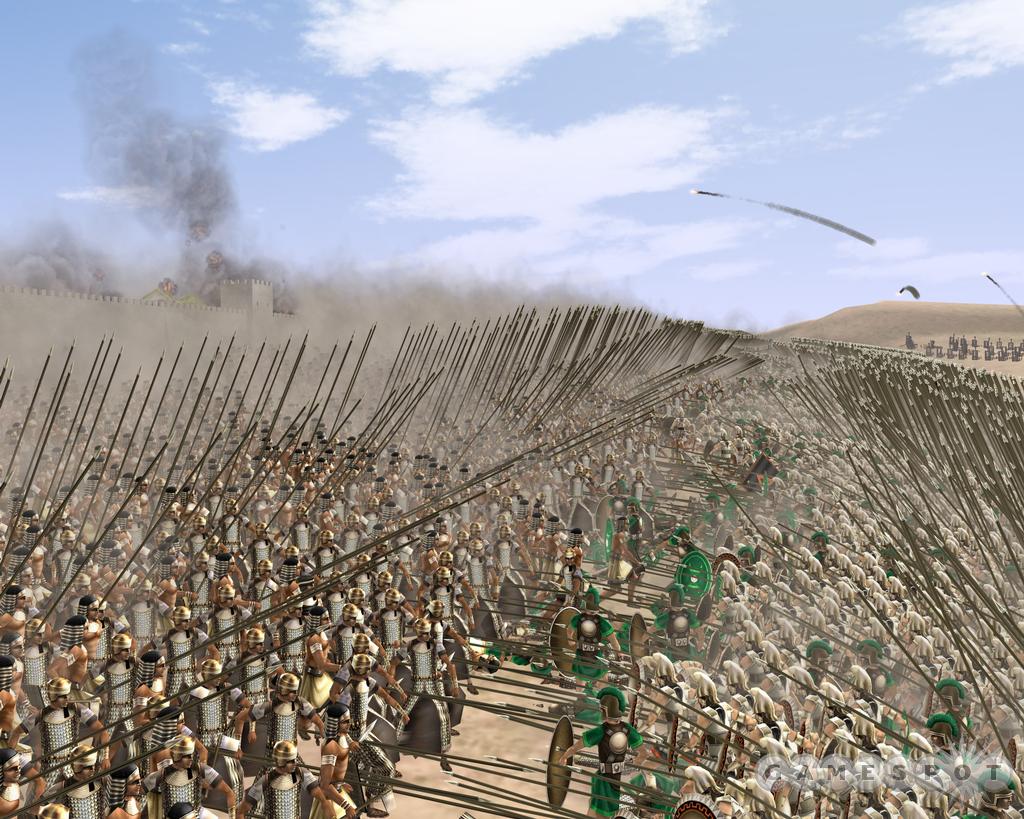
Creative Assembly acknowledges that combat in Rome: Total War is a rock-paper-scissors affair. Basically, that's one way to say that infantry can defeat cavalry, archers can defeat infantry, and cavalry can defeat archers. While that's essentially true, winning battles is still tactically challenging. The thing you'll quickly discover is that armies are huge organizations that can fall apart in a heartbeat if not properly led or organized. That means that you have to pay careful attention to not only what the enemy is doing, but also to what your troops are up to. Generally, it's a good idea to put your infantry and spearmen in front, with archers and other ranged troops behind them, and the cavalry on the flanks. Of course, it's never that easy. First of all, terrain is one thing that can get in your way as battlefields are never fought on perfectly flat surfaces. There are always woods, or a village, or a slight rise or dip in the landscape that will present tactical challenges. Another challenge is that Rome: Total War models morale for all your men, so green troops will break much easier than veteran troops. It's preferable to have a smaller, elite army rather than a large, inexperienced one filled with conscripts and raw recruits. In the case of the latter, all you need are a few men to start running before your entire army loses its composure and starts running.
Testudo Time
While you can adapt to the challenges presented by the terrain, the biggest challenge during battle is simply that of the oldest maxim in warfare: no plan survives first contact with the enemy. An example of this is when we were in a battle in which our legions were spread out in a long line and horse archers suddenly appeared and attacked. We quickly ordered our troops into the famous testudo, or turtle, formation, so that they interlocked their shields to form a giant metal shell to protect them from arrows. While our cavalry was dispatched to chase down the horse archers, we didn't notice that the enemy cavalry saw that our legions were extremely vulnerable. That's because while their shields are interlocked, our troops can't fix their spears at the enemy. Before we realized it, several cavalry charges literally carved apart our infantry, and the morale of the remaining troops quickly shattered and they began to run, which is never a good idea against cavalry. The enemy cavalry simply ran our troops down, and only a handful of Romans survived the battle. We had to replay the battle a second time and pay careful attention to the disposition of enemy cavalry; the moment they began to charge, we hurriedly got the troops out of testudo formation and into a line formation that could withstand the onslaught of the charging cavalry.
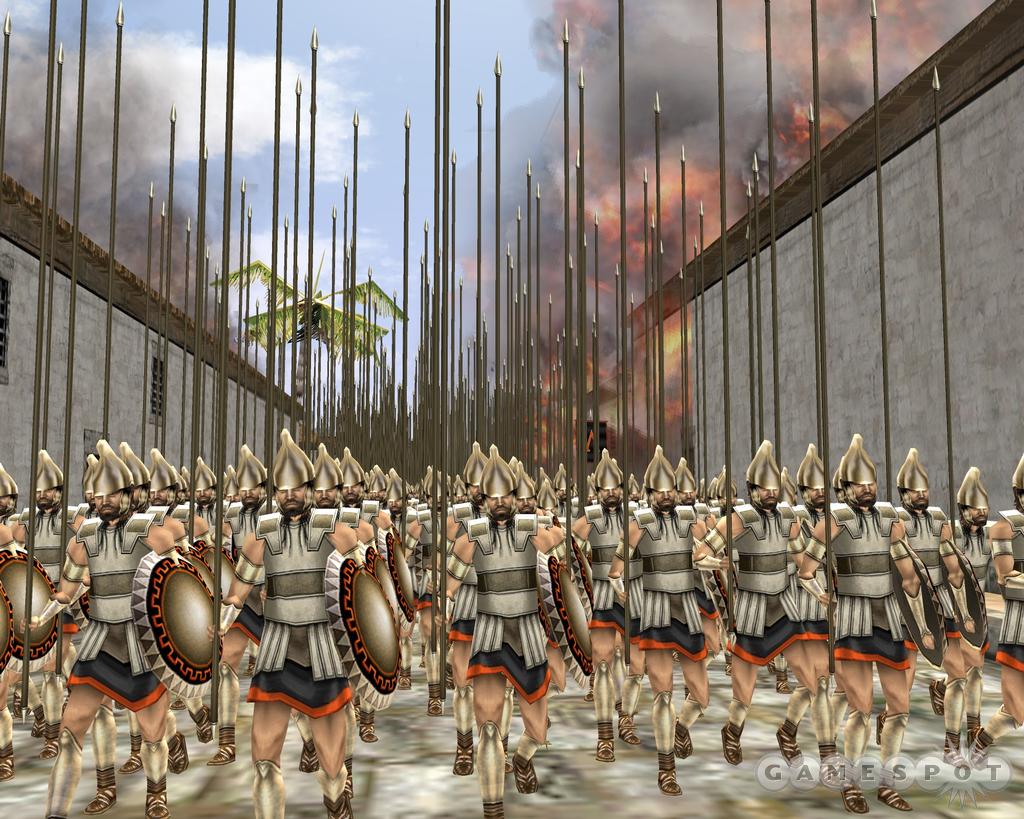
In another battle, we launched an assault on a besieged city. When you siege a city, you'll have a number of options. You can encircle the city until its food supply runs out, which can take about six turns (or three years). But if you're pressed for time (which you'll often be in Rome: Total War), you can build siege weapons and then attack. Of course, we chose the latter. City sieges are spectacular events, because you can literally knock the walls down with your siege weapons or run your battering ram up to the gates and kick down the doors. At least, that's the theory, because attacking a city is still an iffy proposition that can cost you a lot of men if you're not careful. For instance, even if you knock a gap open in a city's walls, you still have to get your troops through it while enemy archers shoot arrows on your formations all the way to the base of the walls. Then, your legions will have to break formation to enter through the narrow gaps, and enemy infantry will be waiting to greet them on the other side.
A city is not considered captured until you can clear the main central square of enemy forces, so you'll have to battle through the city's streets, and urban warfare is never easy. Once again, the goal is to coordinate your forces so that they work as a whole, rather than as disparate pieces, otherwise they'll be chewed up by the enemy. Finally, you want to make sure that you win the battle with a sizable number of troops still alive, because you'll quickly discover that a captured city and a happy city are not the same thing in Rome: Total War. You'll need to occupy captured cities with strong garrisons, otherwise the city will rise up in revolt and kick your forces out, and you'll have to repeat the process again.
We found that controlling all the action in Rome: Total War is easy, thanks to the control scheme. Admittedly, the camera controls in Shogun and Medieval were a bit awkward and clumsy, so Creative Assembly reworked them for Rome. The result is that the camera is much more intuitive and familiar for real-time strategy veterans. One nice new feature is that if you click and hold the middle mouse button, the camera will instantly switch to a close-up view of the most interesting part of the battle, as decided by the computer. Release the middle mouse button and the camera switches back; this allows you to get a taste of the action without losing the larger strategic view.
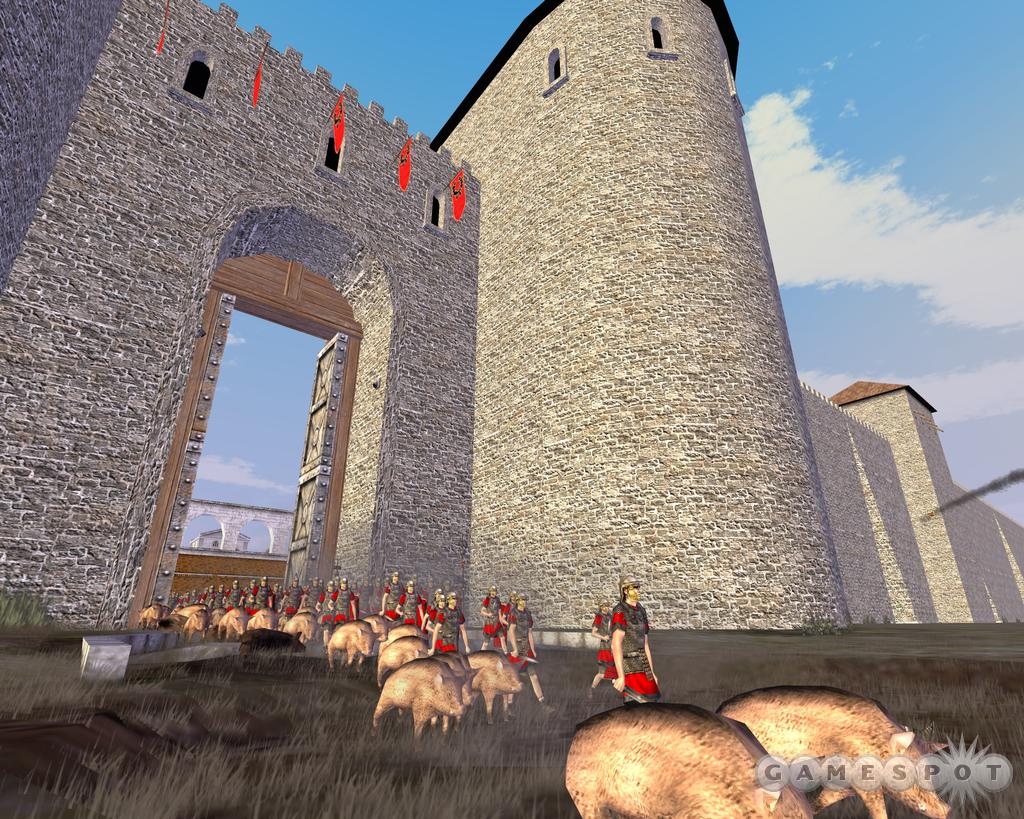
Rome: Total War looks spectacular, thanks to the new 3D engine. The first two Total War games rendered the terrain in 3D, but all the units were rendered as two-dimensional sprites. As a result, battles had a tendency of turning into huge, incompressible scrums when all the sprites coalesced into a big lump on the screen. But now everything is rendered in 3D, and it's quite a sight to watch dozens of cavalry charge through enemy formations. A built-in physics engine means that bodies fly through the air when they're hit by a charging horse, and a cavalry charge is almost like watching a bowling ball cut down pins. Meanwhile, another benefit of the 3D engine is that you can zoom down and watch as each man fights for his life. Soldiers will get in confrontations with each other and hack away until one is dead. We should also note that the audio is also impressive, thanks to the powerful and memorable music, as well as the various sound effects and voice acting.
We're very excited about Rome: Total War, and it's undoubtedly one of the biggest strategy games of the year. The game looks like it's coming together excellently, and the good news is that Creative Assembly is wrapping up development, and we'll soon have an opportunity to see the fruits of its labor. For now, feel free to download the newly-released demo, and keep an eye out for our full review when the game ships sometime next month.
Got a news tip or want to contact us directly? Email news@gamespot.com
Join the conversation